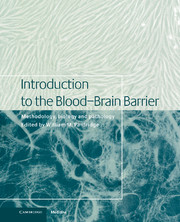Book contents
- Frontmatter
- Contents
- List of contributors
- 1 Blood–brain barrier methodology and biology
- Part I Methodology
- Part II Transport biology
- Part III General aspects of CNS transport
- Part IV Signal transduction/biochemical aspects
- 31 Regulation of brain endothelial cell tight junction permeability
- 32 Chemotherapy and chemosensitization
- 33 Lipid composition of brain microvessels
- 34 Brain microvessel antigens
- 35 Molecular dissection of tight junctions: occludin and ZO-1
- 36 Phosphatidylinositol pathways
- 37 Nitric oxide and endothelin at the blood–brain barrier
- 38 Role of intracellular calcium in regulation of brain endothelial permeability
- 39 Cytokines and the blood-brain barrier
- 40 Blood–brain barrier and monoamines, revisited
- Part V Pathophysiology in disease states
- Index
38 - Role of intracellular calcium in regulation of brain endothelial permeability
from Part IV - Signal transduction/biochemical aspects
Published online by Cambridge University Press: 10 December 2009
- Frontmatter
- Contents
- List of contributors
- 1 Blood–brain barrier methodology and biology
- Part I Methodology
- Part II Transport biology
- Part III General aspects of CNS transport
- Part IV Signal transduction/biochemical aspects
- 31 Regulation of brain endothelial cell tight junction permeability
- 32 Chemotherapy and chemosensitization
- 33 Lipid composition of brain microvessels
- 34 Brain microvessel antigens
- 35 Molecular dissection of tight junctions: occludin and ZO-1
- 36 Phosphatidylinositol pathways
- 37 Nitric oxide and endothelin at the blood–brain barrier
- 38 Role of intracellular calcium in regulation of brain endothelial permeability
- 39 Cytokines and the blood-brain barrier
- 40 Blood–brain barrier and monoamines, revisited
- Part V Pathophysiology in disease states
- Index
Summary
Introduction
Calcium is an important trigger and regulator of endothelial cell physiology. Historically, most information has come from the study of endothelial cells in culture, chiefly cells from large vessel endothelia such as aorta and umbilical vein. More recently, cultured microvascular endothelial cells have been investigated, and some studies have been done on endothelial cells in intact and split-open vessels, or covering the surface of cardiac valves. Studies on brain microvascular endothelium have begun more recently. This chapter reviews studies on the mechanisms governing changes in intracellular calcium involved in the normal physiology of systemic endothelium, evidence that calcium contributes to the control of endothelial permeability in both non-brain and brain endothelium, and cellular mechanisms demonstrated in brain microvascular endothelial cells.
Mechanisms controlling elevation of intracellular calcium in mammalian cells
Cytoplasmic free calcium controls a large number of cellular functions, from the activation of enzymes, to secretory processes and contraction. In mammalian cells, elevation of intracellular calcium occurs from two sources: Ca2+ release from intracellular stores, and Ca2+ influx across the plasma membrane. Two major classes of tetrameric calcium channels control intracellular calcium release, the ryanodine receptor (RR), and the inositol trisphosphate receptor (InsP3R) (Berridge, 1993). In skeletal muscle, the RR is directly coupled to dihydropyridine receptors in the T-tubular plasmalemma, so that membrane depolarization during an action potential leads to intracellular calcium release.
- Type
- Chapter
- Information
- Introduction to the Blood-Brain BarrierMethodology, Biology and Pathology, pp. 345 - 353Publisher: Cambridge University PressPrint publication year: 1998
- 13
- Cited by

